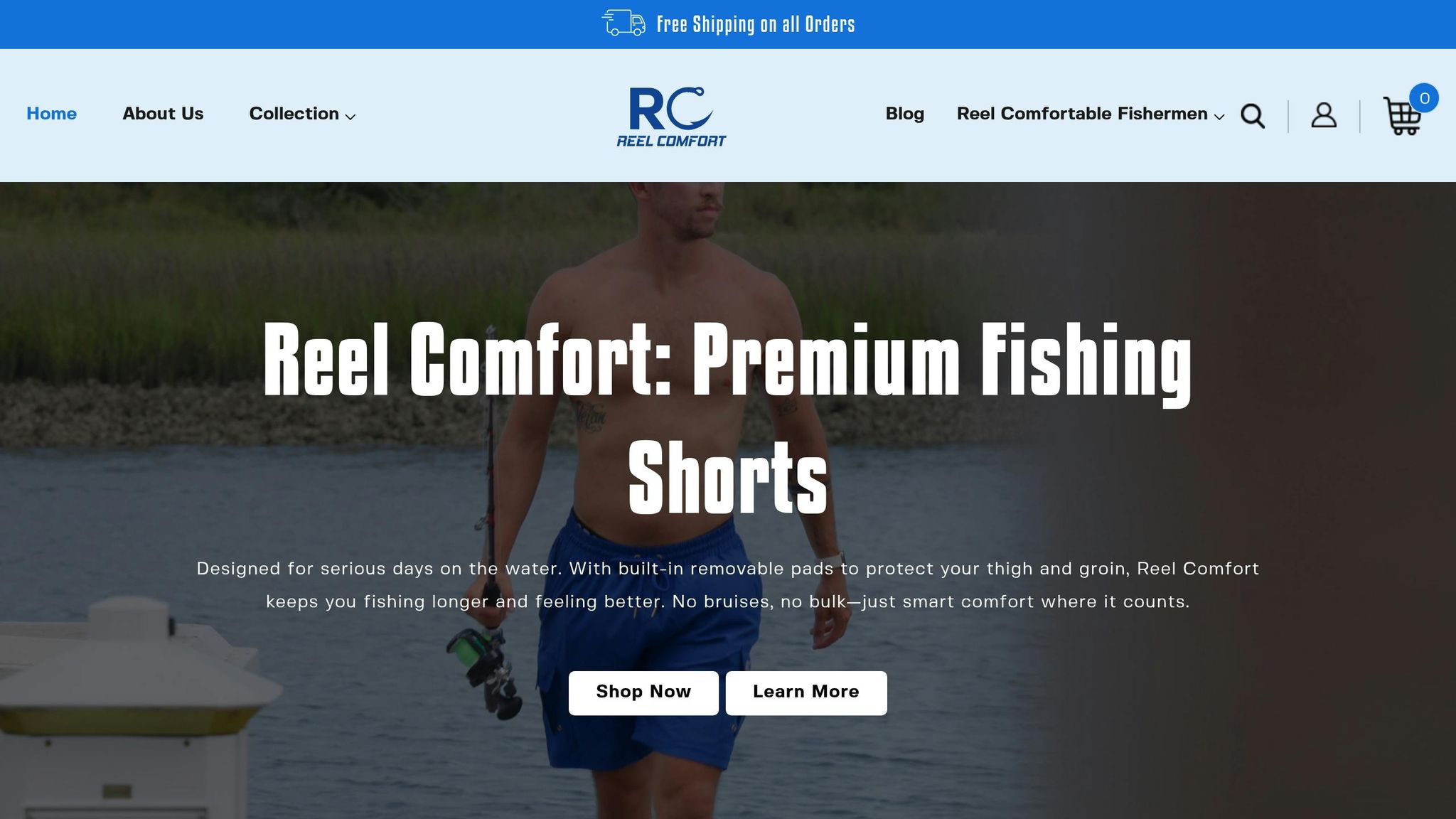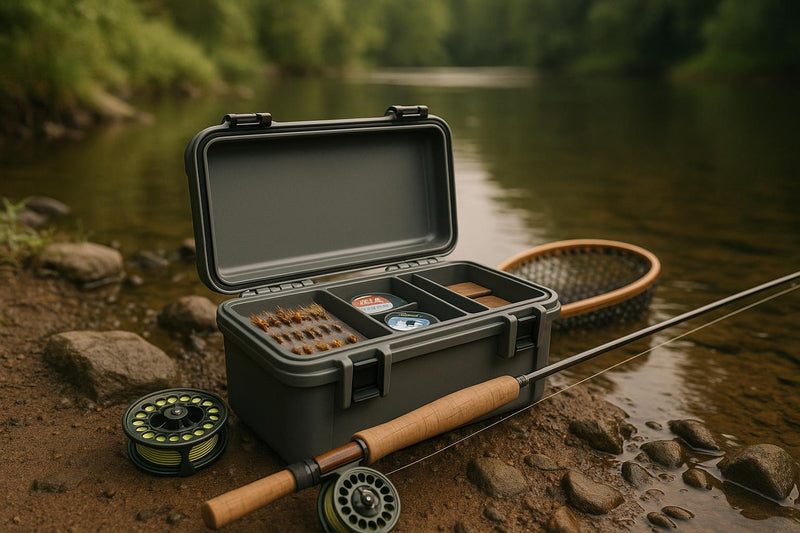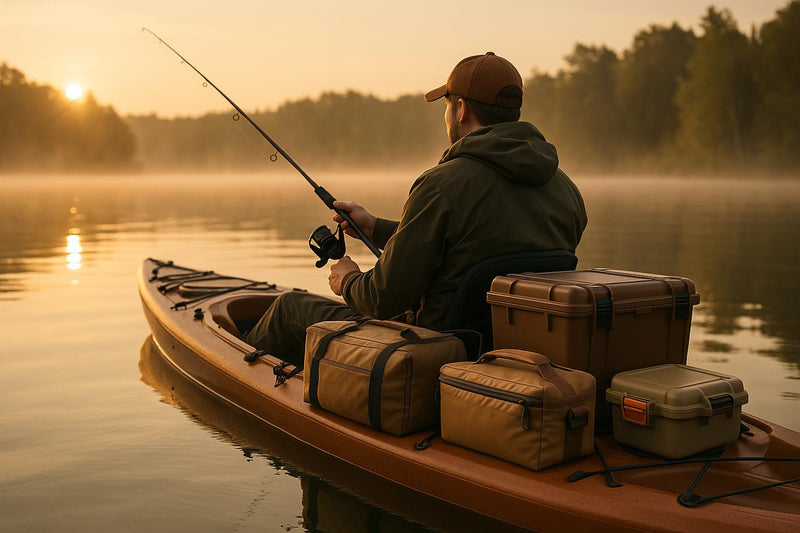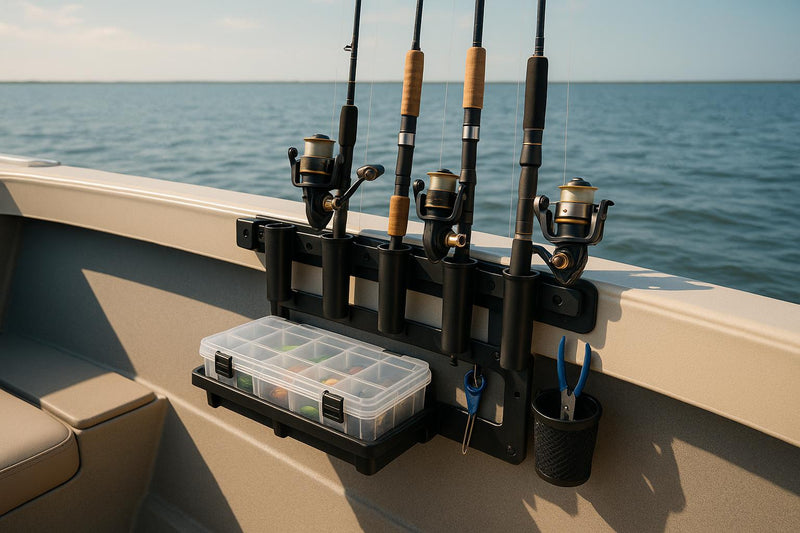Multi-rod fishing can help you catch more fish by letting you use multiple setups at once. To get the most out of this technique, you need the right gear to stay organized, efficient, and comfortable. Here's a quick breakdown of what you need:
- Fishing Rods and Reels: Use rods tailored to your fishing style (spinning, casting, or trolling) and pair them with reliable reels like the Okuma Ceymar C-30 or Abu Garcia Revo SX.
- Tackle and Accessories: Stock up on hooks, lures, sinkers, and spare parts. Organized tackle boxes save time when switching setups.
- Rod Holders: Keep your rods secure with holders suited for shore, boat, or kayak fishing. Materials like steel or aluminum work best for durability.
- Comfort Gear: Padded fishing shorts reduce fatigue and provide a stable surface for resting rods during long sessions.
- Safety and Weather Gear: Life jackets, first-aid kits, polarized sunglasses, and waterproof clothing are crucial for staying safe and comfortable.
- Maintenance: Rinse rods and reels after each trip, check for damage, and replace worn-out lines to keep your gear in top shape.
Preparation is key - organize your gear, label rods and tackle, and plan for changing conditions. With the right setup, multi-rod fishing can transform your time on the water into a more productive and enjoyable experience.
The 4 Rods I ALWAYS keep in the boat!
Core Gear Checklist for Multi-Rod Fishing
Choosing the right gear can make or break your multi-rod fishing experience. The secret is assembling a setup that keeps you organized, efficient, and comfortable while managing multiple lines. Let’s break it down into three essential categories to set you up for success.
Fishing Rods and Reels
Your rods are the backbone of your multi-rod system, so picking the right ones is crucial. A 7-foot, medium-power, fast-action spinning rod is a great all-rounder. It’s versatile enough for anything from finesse fishing for bass to heavier jigging for pike, meaning you can adapt without constantly swapping gear.
Pair your rod with a 2500-size spinning reel, spooled with 10-pound braid. OutdoorGearLab tested 11 reels over six years, and the Okuma Ceymar C-30 stood out as their top pick for its performance and affordability. If you’re ready to spend a bit more, the Abu Garcia Revo SX is praised for its ergonomic design and durable build.
“At eight ounces, it's one of the lightest reels I tested and it feels barely noticeable on many of my rods. It's one of my more balanced setups.” - Jon Oleson, Tester, OutdoorGearLab
Consider the type of fishing you’re doing. Spinning rods are ideal for lighter lines and smaller fish like bass and panfish, while casting rods with baitcasting reels handle heavier lines and larger catches. If you’re fishing from a boat, trolling rods are a must - they’re built for pulling bait behind a moving vessel, thanks to their stiff butt sections and flexible tips.
The key to multi-rod fishing is having setups tailored to specific scenarios. This ensures you’re ready for any conditions without losing time adjusting your gear.
Tackle and Accessories
Managing multiple rods means your tackle box becomes even more important. Stock a variety of lures in different sizes, colors, and actions so you can quickly adapt to what the fish are biting. This saves you from constantly re-rigging your lines.
Pack the essentials: hooks, sinkers, swivels, and lures suited for different conditions. For multi-rod setups, circle hooks in larger sizes are a smart choice - they reduce the chances of deep-hooking fish, which is especially handy when juggling several lines. Make sure you have sinker weights to prevent your lines from drifting and tangling.
Don’t forget spare parts. Extra rod tips, backup reel spools, and additional line are lifesavers when equipment fails - a common issue when running multiple setups. For bait, keep a mix of options like pilchards, skipjack, and squid to match local feeding habits.
To stay organized, use tackle trays or boxes with clear compartments. This makes it easy to grab what you need when switching rods or adapting to changing conditions. And if you’re using braided lines, it’s often quicker to cut and retie than to untangle complicated knots.
Rod Holders and Storage Solutions
Once your rods and tackle are ready, rod holders become essential for keeping everything secure and accessible. They help you manage multiple lines without getting tangled up. The type of holder you need depends on whether you’re fishing from shore, a boat, or a kayak.
For boat anglers, options like overhead rod racks, gunnel mounts, transom mounts, or bulkhead mounts are great for keeping rods organized. These range from compact 6-rod racks to larger systems that can hold up to 16 rods.
If you’re fishing from the shore, dual-rod holders or sand spikes are affordable and effective. Adjustable holders are especially useful in areas with strong currents, as they help minimize tangles.
The material of your rod holders matters too. Steel holders are the most durable for heavy-duty use, while aluminum offers a good balance of strength and heat resistance. High-strength plastic works fine for casual fishing but won’t hold up in tough conditions.
Always carry a few backup rod holders, and if your boat has multiple uses, opt for models that are easy to remove. For transporting and storing your rods, invest in protective cases to keep your gear safe.
To extend your gear’s lifespan, take proper care of it. Support both the butt and midsection of your rods when storing them, and avoid storing them wet. Use racks to prevent warping, and if you’ve been in saltwater, rinse and dry your rods thoroughly to avoid corrosion. A little maintenance goes a long way in preserving your multi-rod setup.
Padded Fishing Shorts for Better Comfort
Spending long hours managing multiple fishing rods can be tough on your body. The constant movement, bending, and handling can lead to fatigue, which is why having gear that minimizes discomfort is so important. Padded fishing shorts are specifically designed to address these challenges, helping you stay comfortable and focused during your fishing sessions. Let’s dive into their key benefits, standout features, and how they can elevate your fishing experience.
Why Choose Padded Fishing Shorts?
Padded fishing shorts offer much-needed protection during extended fishing trips. For example, when you're battling a fish with spinning tackle, the rod butt often digs into your hip or thigh, causing irritation or even bruising. These shorts feature built-in cushioning that evenly distributes pressure, making those long fights with your catch far more comfortable.
The materials used are equally impressive. Many padded shorts are crafted from blends of nylon and polyester, which wick away moisture to keep you dry. Ripstop fabrics add durability, resisting tears and abrasions. And for those long days under the sun, UPF-rated fabrics provide protection from harmful UV rays. Plus, their quick-drying properties mean you won’t have to deal with soggy, chafing shorts after a splash or wade in the water.
Practicality is another highlight. Thoughtfully placed pockets, including dedicated compartments for pliers and other tools, ensure your essentials are always within easy reach, saving you time and hassle while out on the water.
Features of Reel Comfort Padded Fishing Shorts

Reel Comfort takes these benefits a step further with advanced features designed for serious anglers. These padded fishing shorts, priced at $59.99, are built for performance and convenience.
One standout feature is the removable thigh pads. These provide a stable, cushioned surface to rest your rod, eliminating the awkward balancing act or the risk of damaging your rod on boat rails. The shorts also feature four-way stretch fabric, giving you complete freedom of movement whether you’re casting, reeling, or navigating a kayak.
"Designed for serious anglers, our shorts offer strategic padding and quick-dry fabric, helping you stay cool, supported, and focused on the catch." - Reel Comfort
Durability is a priority, too. Reinforced stitching and ergonomic anti-chafe seams ensure the shorts can handle the wear and tear of active fishing. Storage is another strong point, with deep hand pockets, a secure zippered back pocket, and slim thigh-pad compartments to keep your gear organized without adding unnecessary bulk. And when it’s time to clean up, simply remove the thigh pads, toss the shorts in the washing machine with cold water, and air dry.
Making Multi-Rod Fishing Easier
When fishing with multiple rods, efficiency is key. Padded shorts can make a big difference by providing a stable rest for one rod while you’re rigging another or checking your bait. This is especially useful when you’re balancing in a kayak or moving around on a boat.
Florida Bass Angler Jason M. shared his experience:
"The shorts allow him to rest his rod on his thigh without scraping the handle, which makes a huge difference when tying knots while standing in his kayak." - Jason M.
Saltwater angler Reggie K. noted another advantage:
"He no longer has to lean his rod on the boat rail or risk it slipping into the water because he can lean it on the pad." - Reggie K.
Tournament Angler Carlos R. added:
"The pads are soft but hold the rod steady." - Carlos R.
The quick-dry, water-resistant fabric keeps you comfortable as you move between fishing spots or deal with unexpected splashes. If you’re ready to upgrade your fishing gear, check out Reel Comfort’s full collection of padded fishing shorts and their Men’s Fishing Shorts, designed to combine comfort, durability, and performance for your next adventure.
sbb-itb-cb0a783
Safety and Comfort Accessories
When you're out on the water for hours, especially in remote areas, having the right safety and comfort gear isn't just helpful - it can be a lifesaver. Here's what you need to stay safe and comfortable while multi-rod fishing.
Safety Equipment
Safety should always come first. Start with a properly fitting life jacket for everyone on board - non-negotiable.
A well-stocked first-aid kit is another must. It should include essentials like bandages, antiseptics, pain relievers, and any personal medications. With multiple rods and sharp tackle in play, cuts and minor injuries are more likely, so being prepared to treat them on the spot is crucial.
Don’t forget communication tools. An emergency radio and a GPS device that works even without cell service can be literal lifesavers in isolated areas. These tools ensure you can call for help or share your location when needed.
Weather Protection Gear
Weather can change in an instant, and being prepared can make all the difference between a miserable trip and a smooth one.
Polarized sunglasses are a must - not just for reducing glare but also for protecting your eyes from harmful UV rays. Pair those with sunscreen and a wide-brimmed hat or one with UPF 50+ protection to shield your skin from the sun and keep the wind at bay.
For clothing, think layers. Start with moisture-wicking base layers to keep sweat off your skin, and add a waterproof, breathable jacket to keep dry from ocean spray or surprise rain showers. This combo helps you stay comfortable no matter how the temperature shifts.
Want to dig deeper into how water-resistant gear works? Check out our guide on how water-resistant gear protects anglers. It’s packed with tips to keep you dry and ready for anything.
Organizing and Maintaining Multi-Rod Gear
Keeping your multi-rod setup organized and well-maintained isn’t just about convenience - it’s about protecting your gear and maximizing your chances of success. When you’re managing several rods, every second matters, and a solid system can mean the difference between reeling in a trophy fish or missing your shot.
Gear Organization Methods
Using modular rod racks or holders is a smart way to keep your rods upright, tangle-free, and ready for action. These systems also make transportation safer and more efficient. To make things even easier, label your rods and tackle compartments with waterproof markers or colored tape. Include details like line weight and lure type so you can quickly grab the right gear for the job at hand.
For tackle, modular storage systems are a game-changer. Adjustable tackle bags let you sort your lures, hooks, and terminal tackle by type or target species. Stackable trays or bins help you quickly swap gear based on changing conditions. Adding labels to these compartments further streamlines your setup, saving you time and frustration on the water. Even the clothing you wear can play a role in staying organized.
Using Mens Fishing Shorts for Tool Storage
Beyond tackle bags and racks, the right clothing can make a big difference. Mens Fishing Shorts from Reel Comfort, for instance, come with multiple pockets designed to hold essential tools like pliers and line cutters. Their ergonomic design and removable thigh pads not only enhance comfort but also help reduce fatigue during long fishing sessions, especially when juggling multiple rods.
When using shorts with functional pockets, think about accessibility. Place your most-used tools - like pliers - in the easiest-to-reach spots. Sharp or pointed tools should go in dedicated pockets for safety. A practical layout might include pliers in a thigh pocket, line cutters in another, and a small tackle box or measuring tape in a back pocket.
Basic Maintenance Tips
Good maintenance habits separate successful anglers from those dealing with constant gear issues. After every trip, rinse your rods and reels with fresh water to remove dirt and salt. Check rod guides and reel seats for damage, lubricate reel gears, and replace any frayed lines immediately.
Don’t overlook your fishing line. Replace damaged sections as needed, and consider re-spooling all your reels at the start of each season to avoid unexpected failures.
For more tips on keeping your gear in top shape, check out our guide on how water-resistant gear protects anglers.
Finally, create a pre-trip checklist to inventory your gear before and after each outing. This helps prevent loss and ensures everything is in working order. Many anglers swear by carrying a backup rod and reel - having a spare can save the day if something breaks. Tailor your maintenance routine to your fishing conditions: rinse thoroughly after saltwater trips, secure gear on boats to prevent shifting, and use lightweight solutions for shore fishing.
Getting Ready for Multi-Rod Fishing Success
Once your tackle system is in order, the next step for multi-rod fishing success is thoughtful pre-trip planning. Professional angler John Gillespie highlights the importance of organizing tackle based on the species you're targeting:
"I arrange my tackle boxes according to the species I'm after. I have a walleye box, bass box, panfish box and trout box. All are labeled so they are easy to find in the boat."
This method proves especially useful when handling multiple rods, where quick access to the right gear can make all the difference.
Another critical aspect of preparation is checking your line condition. Experienced angler Pete Maina emphasizes this point:
"Avoid losing fish due to line breakage by checking your main line for strength and frays. And always start with new, fresh fluorocarbon leader material."
If your line shows any signs of wear, replace it immediately. A well-maintained line is essential for handling the demands of multi-rod fishing.
Gear selection also plays a key role in your pre-trip setup. Comfortable and functional clothing can significantly improve your performance. For instance, high-quality Fishing shorts with built-in padding and ample storage can reduce fatigue during long fishing sessions. Reel Comfort’s padded fishing shorts come with removable thigh pads for added support when bracing rods against your leg, along with multiple pockets for organizing tools. Their quick-dry fabric technology ensures all-day comfort, making them a great choice for extended time on the water.
Beyond clothing, strategic preparation ties everything together. Pete Maina advises anglers to think ahead:
"Think the day through and prioritize structure and methods you think will work best. This way you can prep rods and tackle for the best presentations. Having thought of secondary structure targets and methods will ensure you have the proper set up ready, including live bait, bobbers, sinkers and all the miscellaneous items for your chosen presentation."
Don’t overlook the practical essentials. Check local fishing regulations, inspect your landing net and boat plug, and ensure you have sunscreen and rain gear ready. If you’re trailering your boat, take the time to grease bearings and check tire pressure.
Lastly, refining your casting techniques is always a good idea. Improved accuracy and distance can elevate your fishing game. Keep your gear neatly organized in a dedicated tackle bag or backpack so you can grab what you need in seconds.
With careful planning, reliable gear, and a focused mindset, you’ll be set to make the most of every opportunity multi-rod fishing has to offer.
FAQs
What are the benefits of using multiple fishing rods, and how can I manage them effectively?
Using more than one fishing rod can take your fishing game to the next level. It gives you the chance to try out a variety of baits, lures, and techniques all at once, boosting your odds of landing a catch. Plus, you can cover different water depths and areas more efficiently, which is especially useful in varied fishing spots or during competitions.
To keep things manageable, rod holders are a great addition - they help keep your gear organized and free up your hands. Having extra setups ready to go can also save you time when switching equipment. Staying prepared and keeping your gear in order can make your fishing trips smoother and more productive.
How do I choose the best rod and reel combination for different fishing situations?
Choosing the right rod and reel combo hinges on a few key factors: the type of fishing you’re doing, the species you’re after, and the environment you’re fishing in. For lighter lines or finesse techniques, a 6-foot spinning rod is a solid pick. If you’re casting from the shore and need extra reach, go longer - 7 to 7.5 feet is ideal. On the other hand, shorter rods are more practical for boat or kayak fishing, where maneuverability is key.
When targeting bass, a medium or medium-heavy rod paired with a reel sporting a 5:1 or 6:1 gear ratio offers great versatility. If you’re venturing into saltwater, durability is crucial. Look for rods made from tough materials like graphite or fiberglass, and choose the rod length and action based on the size of the fish you’re chasing. Don’t forget to match your reel size and line weight to your rod for smooth performance.
The best setup boils down to understanding your target fish, where you’re fishing, and the techniques you enjoy using.
How can I keep my multi-rod fishing gear organized and in good condition for long-term use?
To keep your multi-rod fishing gear in top shape and ready for action, start by giving your rods, reels, and tackle a good clean after every trip. Make sure they’re thoroughly dried to ward off rust and corrosion - this is especially important if you’re fishing in saltwater or humid areas.
When it comes to storage, rod racks or protective cases are your best friends. They’ll keep your rods safe from tangling or accidental damage. For your tackle and accessories, consider using compartmentalized storage boxes. These boxes not only keep your gear organized but also make it easier to find what you need. Adding labels to the compartments can save you precious time when you’re out on the water.
Don’t forget to inspect your gear regularly. Check for frayed lines, loose reel parts, or any other signs of wear and tear. Repair or replace anything that’s not in good condition. Taking these simple steps ensures your equipment lasts longer and keeps you ready for your next fishing trip.




